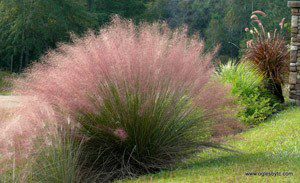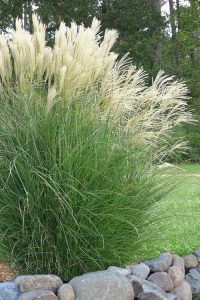
As the seasons change so does our outdoor landscape. Some plants are languishing while others are chugging along producing flowers. A beautiful and easy-to-maintain addition to a landscape are ornamental grasses. They add subtle colors this time of year, bringing interesting textures and contrast when summer plants are starting their winter break.
Recently, interest in ornamental grasses has increased as a landscape plant so nurseries have begun developing new cultivars. There are several ornamental grasses that grow in our area that are native, making them very easy to manage. Ornamental grasses are a diverse group of specific grasses for many different types of landscape areas. Some do well in wetter areas, while some can take the dry heat. Some do well in shade while most tolerate a lot of hot sun. Almost all of them are fairly maintenance free.
Landscape Requirements
Finding the right ornamental grass for a landscape may take researching a wide variety of possibilities. Knowing the landscape requirements is essential as well as understanding how the grass will react in the landscape environment. Many grasses will change with each season, adding interest and uniqueness to each bed. A few grasses, like Mondo grass will stay ever green and not grow or change much at all. Some grasses are annual, and some grasses are perennial. A perennial grass will live year after year whereas an annual will live for only one year. Annuals will die after flowering or be killed by a frost.

Grasses can be grouped into two categories; clumpers and spreaders (or creepers). For the purpose of this blog we are going to limit our information to clumpers. Grasses that spread would be appropriately used as a ground cover because over time, that’s what they would do…. creep into new areas. We want to focus on ornamental grasses that will enhance a bed with color and interest throughout the season but will not spread itself in the bed. Clumping grasses will get a little wider, but they will not creep to other areas.
The size of the plant and the size of the area in the landscape must match. Warm weather grasses can start out fairly upright and “skinny” but can end up by the end of growing season, much taller and wider and eventually, depending on the cultivar, drooping and taking up twice the space that was used in the spring. So, knowing the mature size of the grass is very important.
Care and Maintenance
Grasses can be pruned in midwinter if that is required or, like Lemon Grass, may not have to be cut back but have dead leaves that can be cleaned out. Many people don’t like the dead leaves to remain and overtime (years) they will inhibit the growth of the grass. Cleaning out the dead leaves and flower stalks during the winter will make the grasses look fresh in the spring and also a little smaller. Dead stalk and leaves of grasses are often sharp and will cut your skin so always wear gloves when working with the grass.
Like all new plantings, grasses need water until established. Even the native ones need water to get started. Most grasses (unless they are happier in the water) will not need much water after they are established. Also, unlike that pretty Plumbago, an ornamental grass may not look its best when you buy it and after planting. Give it time. In a year it will be beautiful and when the fronds come along (in summer or fall) you will love it.
Let’s look at just a few of the wonderful clumping grasses, native and nonnative:
- Muhly grass: fall blooming, white, pink- native, and dark pink, about 1’x1’
- Fountain grass: nonnative, all season bloom, purple, beige, and red, about 2’-3’x 8”
- Lemon grass: nonnative, herb, no bloom, about 4’ x 3’
- Maiden grass: nonnative, beige bloom, has seed head, about 1’ x 1’
- Bamboo Muhly: native, insignificant bloom, about 5’ x 3’
- Miscanthus Adagio: nonnative, fall bloom, beige, about 1’ x 1’
 0
0
